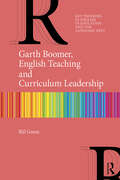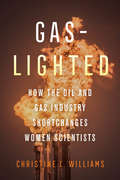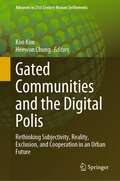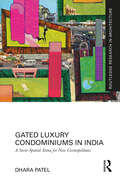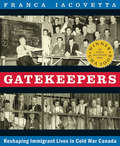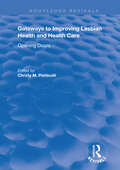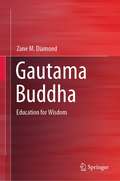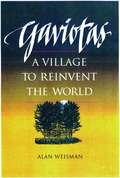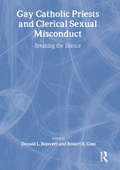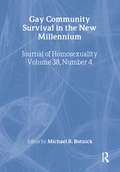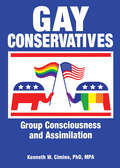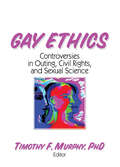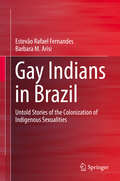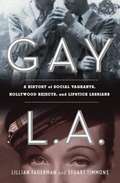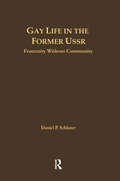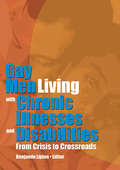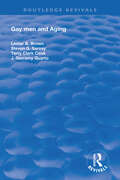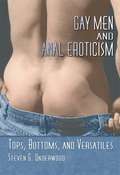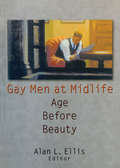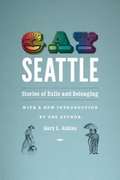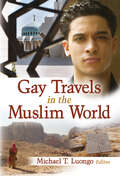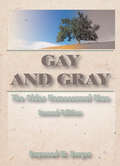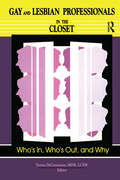- Table View
- List View
Garth Boomer, English Teaching and Curriculum Leadership (Key Thinkers in English in Education and the Language Arts)
by Bill GreenThis book provides a broad introduction to the critical work of leading Australian educator Garth Boomer, widely recognised as a significant figure in English teaching. This insightful text provides an accessible introduction to his work, with particular reference to English curriculum and pedagogy, and provides a fascinating account of his journey as a scholar-practitioner, from classroom teaching to the highest levels of the educational bureaucracy.Bill Green explores Boomer’s huge influence on literacy education, teacher development, curriculum inquiry, and educational policy, and critically asks why Boomer’s insights and arguments about English teaching from the last century have such importance for the field now. This text also focuses on the nature and significance of his curriculum thinking, specifically his arguments and provocations regarding English teaching, the English classroom, and the contexts that infuse and shape them. It constitutes a rich resource for rethinking English teaching in the present day and provides an important contribution to the historical imagination.With all due consideration of the larger context of social life and educational thought, this text will help any student of English in Education and Language Arts obtain a deeper understanding of Boomer’s vital contribution to the field of education.
Gaslighted: How the Oil and Gas Industry Shortchanges Women Scientists
by Christine L. WilliamsThe oil and gas industry is one of the richest and most powerful industries in the world. In recent years, company avowals in support of diversity, much-touted programs for "women in STEM," and, most importantly, a tight labor market with near parity in women pursuing geoscience credentials might lead us to expect progress for women in this industry's corporate ranks. Yet, for all the talk of "the great crew change," the industry remains overwhelmingly white and male. Sociologist Christine L. Williams asks, where are the women? To answer this question, Williams embarked on a decade-long investigation—one involving one hundred in-depth interviews, a longitudinal survey, and ethnographic research—that allowed her to observe the industry in times of boom and bust. She found that when the industry expands, women may be able to walk through the door, but when the industry contracts, the door becomes a revolving one, whirling ever faster, as companies retreat to their white male core. These gendered outcomes are obscured by firms' stated commitments to diversity in hiring and the language of merit. The result is organizational gaslighting, a radical dissonance between language and practice that Williams exposes for all.
Gated Communities and the Digital Polis: Rethinking Subjectivity, Reality, Exclusion, and Cooperation in an Urban Future (Advances in 21st Century Human Settlements)
by Kon Kim Heewon ChungThis edited collection provides an alternative discourse on cities evolving with physically and virtually networked communities—the ‘digital polis’—and offers a variety of perspectives from the humanities, media studies, geography, architecture, and urban studies. As an emergent concept that encompasses research and practice, the digital polis is oriented toward a counter-mapping of the digital cityscape beyond policing and gatekeeping in physical and virtual gated communities. Considering the digital polis as offering potential for active support of socially just and politically inclusive urban circumstances in ways that mirror the Greek polis, our attention is drawn towards the interweaving of the development of digital technology, urban space, and social dynamics. The four parts of this book address the formation of technosocial subjectivity, real-and-virtual combined urbanity, the spatial dimensions of digital exclusion and inclusion, and the prospect of emancipatory and empowering digital citizens. Individual chapters cover varied topics on digital feminism, data activism, networked individualism, digital commons, real-virtual communalism, the post-family imagination, digital fortress cities, rights to the smart city, online foodscapes, and open-source urbanism across the globe. Contributors explore the following questions: what developments can be found over recent decades in both physical and virtual communities such as cyberspace, and what will our urban future be like? What is the ‘digital polis’ and what kinds of new subjectivity does it produce? How does digital technology, as well as its virtuality, reshape the city and our spatial awareness of it? What kinds of exclusion and cooperation are at work in communities and spaces in the digital age? Each chapter responds to these questions in its own way, navigating readers through routes toward the digital polis.Chapter "Introduction - The digital polis and its practices: Beyond gated communities" is available open access under a Creative Commons Attribution 4.0 International License via link.springer.com.
Gated Luxury Condominiums in India: A Socio-Spatial Arena for New Cosmopolitans (Routledge Research in Architecture)
by Dhara PatelGated Luxury Condominiums in India: A Socio-Spatial Arena for New Cosmopolitans critically examines gated luxury condominiums in contemporary India, exploring their role in shaping elite power and identity within the framework of neoliberalism. It delves into the spatial structure, perception and post-occupancy experience of these enclaves, offering valuable insights into India's urban development.This book convincingly elucidates the complex socio-spatial transformations underway in India, inviting readers to understand the depth and breadth of these changes, particularly within the rapidly expanding middle and upper-middle classes. It adopts a robust multi-disciplinary approach, combining methodologies such as spatial ethnography, threshold mapping, qualitative interviews and discourse analysis. Focused on the architectural typology of luxury condominiums, the study serves as a lens for broader social transformations grounded in case studies from Mumbai and Pune. Through a meticulous dissection of the lived experiences of various categories of users – owners, visitors and service staff – the book unveils the complex socio-spatial hierarchies perpetuated within these enclaves. Drawing on theories of cosmopolitanism and postcolonial critiques, the monograph makes a significant scholarly contribution to the disciplines of architecture and the built environment. It fills a gap in the existing literature on modern domesticity in India, offering original research that highlights how architecture is instrumental in socially divisive practices of elite formation.It will appeal to scholars, researchers and students across disciplines like architecture, landscape design, spatial sociology, urban studies and area studies, focusing on India and South Asia. It is particularly compelling for those interested in the sociocultural dynamics of the middle class, encompassing themes such as domesticity, material culture and spatial politics within the context of Indian condominiums.
Gatekeepers: Reshaping Immigrant Lives in Cold War Canada
by Franca IacovettaAn in-depth study of European immigrants to Canada during the Cold War, Gatekeepers explores the interactions among these immigrants and the “gatekeepers”–mostly middle-class individuals and institutions whose definitions of citizenship significantly shaped the immigrant experience. Iacovetta’s deft discussion examines how dominant bourgeois gender and Cold War ideologies of the day shaped attitudes towards new Canadians. She shows how the newcomers themselves were significant actors who influenced Canadian culture and society, even as their own behaviour was being modified. Generously illustrated, Gatekeepers explores a side of Cold War history that has been left largely untapped. It offers a long overdue Canadian perspective on one of the defining eras of the last century.
Gateways to Improving Lesbian Health and Health Care: Opening Doors
by Christy M. PonticelliAn interdisciplinary book that creates a space for traditionally oppressed voices to speak, Gateways to Improving Lesbian Health and Health Care explores the health care experiences of lesbians of different ages, colors, and places. By presenting the particular difficulties lesbians have in accessing excellent, or even adequate, health care, this book is meant to convince lesbians who have been isolated that their health issues and interactions with health care professionals are not just personal troubles, but larger public issues. It is also designed to show health care providers how they can sensitize their care and meet the needs of lesbian clients through the provision of safe and respectful environments.As Gateways to Improving Lesbian Health and Health Care addresses the intersection of race, class, and sexuality and how it affects the health care lesbians receive, you learn about lesbians’strategies for coming out to professionals, patient-professional interaction, and the construction of lesbianism as a social problem within the health care arena. You will also learn about: the need to view sexualities as local histories and narratives the invisibility of aging lesbians in health and policy arenas domestic violence in lesbian relationships surviving a series of social identity exclusions the difficulties of finding information on heterosexist or lesbian-friendly health care providers in unfriendly communities personal accounts of prejudices lesbians have encountered when seeking health care struggling with alcoholismLesbian health care consumers, health care educators and providers, social service workers, and those in women's studies programs need to know how health care services often fail lesbians in need. With its practical suggestions for improving health care delivery to lesbians, Gateways to Improving Lesbian Health and Health Care is essential reading for ensuring quality care to lesbians of all ages, backgrounds, ethnicities, and locations.
Gathering Social Network Data (Quantitative Applications in the Social Sciences #180)
by jimi adamsGathering Social Network Data fills an important gap in the literature by focusing on methods for designing, collecting, and evaluating the data that are the subject of these analytic techniques. Author jimi adams draws on his extensive teaching experience to provide a guide that can be used by both novice and more experienced researchers alike. The volume focuses on principles, with the goal of providing readers the tools needed to develop their own approach to gathering social network data.
Gathering Social Network Data (Quantitative Applications in the Social Sciences #180)
by jimi adamsGathering Social Network Data fills an important gap in the literature by focusing on methods for designing, collecting, and evaluating the data that are the subject of these analytic techniques. Author jimi adams draws on his extensive teaching experience to provide a guide that can be used by both novice and more experienced researchers alike. The volume focuses on principles, with the goal of providing readers the tools needed to develop their own approach to gathering social network data.
Gautama Buddha: Education for Wisdom
by Zane M. DiamondThis book examines some of the key elements of Buddhist education theory, in particular about educating for wisdom, the ultimate goal of Buddhist education. The teachings of Gautama Buddha have endured for thousands of years carried into the present era in schools, universities, temples, personal development courses, martial arts academies and an array of Buddhist philosophical societies across the globe. Philosophically, the ideas of the Buddha have held appeal across many cultures, but less is known about the underlying educational theories and practices that shape teaching and learning within Buddhist-inspired educational contexts. The chapters outline the development of the Buddha’s teachings, his broad approach to education and their relevance in the 21st century. Subsequently, the book reviews the history of the evolution of the various schools of Buddhist thought, their teaching and learning styles and the dissemination among Asia and later also the Western countries. The book discusses education theories and devices embedded within the Buddhist teachings, examining the works found in the Tipitaka, the Buddhist canon.
Gaviotas: A Village to Reinvent the World
by Alan WeismanThe story of Gaviotas, a village in a remote area of Colombia once thought uninhabitable, and the simple, affordable technology that was developed there and is now in use throughout Colombia.
Gay Catholic Priests and Clerical Sexual Misconduct: Breaking the Silence
by Robert Goss Donald Boisvert“Why did it take 30 years for American bishops to listen to the victims of Catholic clerical abuse?” Gay Catholic Priests and Clerical Sexual Misconduct: Breaking the Silence is a compelling indictment of Roman Catholic teachings on homosexuality and sexuality. Inspired by The Silence of Sodom: Homosexuality in Modern Catholicism, Mark Jordan’s controversial examination of homoeroticism in American Catholic culture, this groundbreaking book examines how the current crisis of clerical abuse affects and stigmatizes gay priests living in a climate of hysteria and condemnation. The book’s contributors, an eclectic mix of scholars and clerics, question whether the church can survive centuries of secrets and scandals. In the wake of very real concerns about a possible inquisition launched by the Catholic Church against its gay members, Gay Catholic Priests and Clerical Sexual Misconduct continues the efforts of the Gay Men’s Issues in Religion Group of the American Academy of Religion to honor the work of Mark Jordan, who contributes his thoughts on the issues raised by the book. A panel of former Jesuits, a former seminarian with the Congregation of the Blessed Sacrament, a Dominican, a Franciscan, and several feminist authors present different perspectives on gay priests, clerical/ecclesial misogyny, games of power and abuse, and religious scapegoating, writing with eloquence and pain, a great deal of pride, and a touch of justifiable divine righteousness. Gay Catholic Priests and Clerical Sexual Misconduct includes:“Celibate Men, Ambivalent Saints, and Games of Desire”, “A Call to Liberation of Gay Catholic Clergy”, “Speaking Loud or Shutting Up: The Homosexual-type Problem”, “Those Troubling Gay Priests”, “Catholicism and a Crisis of Intimate Relations” and much more! Gay Catholic Priests and Clerical Sexual Misconduct: Breaking the Silence is an invaluable resource for academics, members of the clergy, seminarians, chaplains and counselors, and anyone interested in homosexuality and religion.
Gay Community Survival in the New Millennium
by Michael R BotnickUnderstand the international challenges facing gay male societies! This eye-opening account examines the idealistic, structural, and emotional meanings of community within the gay population. Gay Community Survival in the New Millennium explores the concept of “gay community” as well as the problems and progress that these communities are facing in the United States, Canada, and Israel. As a community leader, gay rights advocate, or policymaker, you will gain insight into issues that must be addressed now in order to strengthen your own community. Gay Community Survival in the New Millennium explores many of the fractures in gay society that must be addressed to ensure progress in the gay liberation movements, including: racial and ethnic divisions in the gay community, especially based on HIV-positive and HIV-negative status, and programs that work to bridge this gap the rift between HIV-positive and HIV-negative gay men based on the allocation of money for social programs meant to support entire gay communities AIDSphobia, the irrational fear of contracting the virus and how it has affected gay communities the Israeli gay rights movement, which is visibly pursuing full and equal citizenship in Israel, including acceptance into the Israeli military projections for gay rights movements in the future if homophobia continues to exist the enormous power that would be created if all gay and AIDS social organizations in a given geographic region banded together to influence change in social policies and eliminate stereotypesGay Community Survival in the New Millennium explores what it means to be a gay man in today's communities, from the fear of AIDS and the need for financing of gay men's social programs to forming a collective organization that will work for the gay men's liberation movements. This essential guide will provide you with suggestions to help you shape and successfully change your gay community.
Gay Conservatives: Group Consciousness and Assimilation
by Kenneth Cimino WDiscover why LGBT voters support conservative political platforms that don&’t benefit the LGBT communityRecent studies show that the vast majority of the LGBT community considers itself politically liberally. Yet nearly 25% of all LGBT voters helped re-elect George W. Bush in 2004-who are these people and why did they make that choice? Gay Conservatives examines why conservative LGBTs join political groups and support political candidates that not only don&’t favor policies that benefit the LGBT community, but in some cases, advocate prejudicial policies. This thought-provoking book looks at the impact of "group consciousness" on conservative LGBTs and how it affects political power and social construction. Gay Conservatives uses both quantitative and qualitative studies that center on conservative LGBTs within in the LGBT community, while using data collected on liberal LGBTs for comparison purposes. Log Cabin Republicans and StoneWall Democrats in several cities were interviewed and an online survey of more than 1,000 LGBTs was conducted by the Gill Foundation in an effort to understand the political identity of conservative LGBTs and how it fits into the bigger picture in the LGBT community. The book examines how-and why-conservative LGBT activity conflicts with the general interests of the community, including the "constitutional" rights of LGBT individuals to marry, whether LGBTs should be allowed to serve openly in the United States military, and whether state and local governments should play a more significant role in dealing with hate crimes directed at the LGBT community.Topics discussed in Gay Conservatives include: group consciousness and minority identity pluralism David Truman the homosexual identity stages the history of the gay liberation movement creating a group identity the Mattachine Society Stonewall the impact of AIDS the rise of "Queer Nation" the difficulties of "coming out" and much moreGay Conservatives is an enlightening and educational read for anyone interested in politics and the political behavior of voters in the United States.
Gay Ethics: Controversies in Outing, Civil Rights, and Sexual Science
by Timothy F MurphyGay Ethics is an anthology that addresses ethical questions involving key moral issues of today--sexual morality, outing, gay and lesbian marriages, military service, anti-discrimination laws, affirmative action policies, the moral significance of sexual orientation research, and the legacy of homophobia in health care. It focuses on these issues within the social context of the lives of gay men and lesbians and makes evident the ways in which ethics can and should be reclaimed to pursue the moral good for gay men and lesbians.Gay Ethics is a timely book that illustrates the inadequacies of various moral arguments used in regard to homosexuality. This book reaches a new awareness for the standing and treatment of gay men and lesbians in society by moving beyond conventional philosophical analyses that focus exclusively on the morality of specific kinds of sexual acts, the nature of perversion, or the cogency of scientific accounts of the origins of homoeroticism. It raises pertinent questions about the meaning of sexuality for private and public life, civics, and science. Some of the issues covered: Sexual Morality Outing Same-Sex Marriage Military Service Anti-Discrimination Laws Affirmative Action Policy The Scientific Study of Sexual Orientation Bias in Psychoanalysis Homophobia in Health CareGay Ethics presents a wide range of perspectives but remains united in the common purpose of illuminating moral arguments and social policies as they involve homosexuality. The chapters challenge social oppression in the military, civil rights, and the social conventions observed among gay men and lesbians themselves. This book is applicable to a broad range of academics working in gay and lesbian studies and because of its current content, is of interest to an educated lay public. It will be a standard reference point for future discussion of the matters it addresses.
Gay Indians in Brazil
by Estevão Rafael Fernandes Barbara M. ArisiThis book unveils an ignored aspect of the Brazilian history: how the colonization of the country shaped the sexuality of its indigenous population. Based on textual research, the authors show how the government and religious institutions gradually imposed the family model considered as "normal" to Brazilian indigenous gays through forced labor, punishment, marriages with non-indigenous and other methods. However, such disciplinary practices didn't prevent the resistance of the natives whose sexuality operates out of the hegemonic model, and the book also analyzes the impact of these forms of dissent on the development of indigenous movements, interethnic relations and indigenous policies in Brazil. Building upon Post-Colonial and Queer theories, the authors present a historical overview of the ideas and practices employed by the religious and governmental authorities to repress homosexuality among indigenous peoples since the beginning of the colonization process, on the 16th century. They also show how this process of colonization of indigenous sexualities goes beyond the formal colonization period, which ended with the Brazilian Independence in 1822, and is part of a wider process of compulsory heterosexualization and heteronormativity of native peoples, based on scientific, theological, social and cultural assumptions that inspired religious, civilizing, academic and political practices throughout Brazilian history.
Gay L. A.: A History of Sexual Outlaws, Power Politics, and Lipstick Lesbians
by Lillian Faderman Stuart TimmonsThe exhortation to "Go West!" has long captured the American imagination. But for the gays, lesbians, and transgendered people who have moved to L.A. over the past two centuries, the City of Angels has offered a special home--which in turn gave rise to one of the most influential gay cultures in the world. Drawing upon untouched archival materials and over three hundred new interviews, Lillian Faderman and Stuart Timmons chart L.A.'s unique gay history, from the first missionary encounters with Native American cross-gendered "two spirits" to cross-dressing frontier women in search of their fortunes; from the same-sex salons of early Hollywood powers such as Alla Nazimova and George Cukor to the explosion of gay life during World War II. They show how underground organizing began locally in the 1950s and spread nationally as well as how L.A.'s radical gay liberation movement of the sixties and seventies evolved into today's power politics. Unparalleled financial resources nurtured an institutionalized lesbian and gay culture that has interwoven with the fabric of national culture. Faderman and Timmons show how geography, economic opportunity, and a constant influx of new people created a city that fostered more lasting gay institutions than any other in America. Combining broad historical scope with deftly wrought stories of real people, from the Hollywood sound stage to the Barrio, Gay L.A. is American social history at its best. LILLIAN FADERMAN is the award-winning author of numerous books on lesbian/gay history, including Surpassing the Love of Men and Odd Girls and Twilight Lovers, which were both named among The New York Times notable books of the year. Her most recent book, Naked in the Promised Land, received the Judy Grahn Award for nonfiction.
Gay Life in the Former USSR: Fraternity Without Community (Issues in Globalization)
by Daniel SchluterThis work describes and analyzes the individual identities, social-ecological "landscape", and group undertakings among the homosexual population of the Soviet Union during the final years of the communist regime.
Gay Men Living with Chronic Illnesses and Disabilities: From Crisis to Crossroads
by Benjamin LiptonUnderstand gay men&’s unique health issues beyond the incomplete focus of HIV to include the concerns of those living with a broad range of chronic illnesses and disabilitiesGay Men Living with Chronic Illnesses and Disabilities: From Crisis to Crossroads is the groundbreaking book that comprehensively examines and forms strategies to respond to the needs of gay men living with non-HIV chronic illnesses and disabilities such as diabetes, cancer, obesity, and muscular sclerosis. Bringing together the interdisciplinary expertise and unique perspectives of leaders in the fields of social work, psychology, and rehabilitation counseling, this groundbreaking book helps you understand the key issues from theoretical, clinical, practical, and personal perspectives. Gay Men Living with Chronic Illnesses and Disabilities: From Crisis to Crossroads conceptualizes and addresses the integration of psychosocial and medical issues faced by the gay men living with both HIV-related and non-HIV chronic illnesses and disabilities. Each chapter delves deeply into the psychosocial impact of their marginalization in daily living while offering strategies for partnership and integration between gay and mainstream health and social service organizations. With extensive, up-to-date bibliographies at the end of each chapter and case studies that illuminate theoretical discussions, this book is essential reading for those involved in health policy and practice with gay men living with chronic illnesses and disabilities.Gay Men Living with Chronic Illnesses and Disabilities: From Crisis to Crossroads explores: the "invisibility" of gay men living with non-HIV illnesses and disabilities and the need to provide adequate services to them the impact of sexual orientation on living with a broad range of life-threatening illnesses the multiple layers of stigma of being gay while living with a chronic illness or disability how chronic illness can lead to increased body dissatisfaction in gay men the multidimensional challenge of psychotherapy with HIV positive gay men the connection between aging, chronic illness, and sexual orientation living with a non-HIV chronic illness as a gay social service professionalGay Men Living with Chronic Illnesses and Disabilities: From Crisis to Crossroads is vital reading for social workers, psychologists, psychiatrists, physicians, sociologists, public health advocates and experts, community organizers, and everyone engaged in providing medical, social, or psychological services.
Gay Men and Aging
by Terry Cook Lester B. Brown J. Geramy Quarto Steven SarosyFirst published in 1997 this study presents the results of three recent studies on aging in homosexual men, focusing on their lives, relationships, hopes and fears, and attitudes about AIDS. Topics include challenges to stereotypes of the older gay male, ageism and heterosexism, social life, and sexual behavior.
Gay Men and Anal Eroticism: Tops, Bottoms, and Versatiles
by Steven G. UnderwoodGay men reveal their preference-and the reasons behind it! Gay Men and Anal Eroticism: Tops, Bottoms, and Versatiles is a no-holds-barred examination of one of society's most persistent taboos. In a remarkably candid collection of frank and forthright interviews, 21 gay men talk about the role anal sex plays in their lives and relationships and their choices to act as insertive ("top") or receptive ("bottom") partners-or both ("versatile"). Ranging in age from 21 to 65, the men discuss the reasons behind (and consequences of) their choices; how they define their sexual roles (and how those roles are defined by gay society); issues of power, trust, and vulnerability; and the concept (in both straight and gay society) that tops and bottoms are socially and morally unequal. These unique interviews, conducted by the author in the Boston and Provincetown areas, celebrate choice in gay men's sexuality while debating whether preference is genetically based or socially formed-a debate largely ignored in social science studies. The men interviewed-including gay porn icon Cole Tucker-discuss perceptions muddied by stereotypes, preconceived notions, and exaggerated scenarios, and the meanings gay men assign to anal sex, including dominance and submission roles related to masculine/feminine, aggressive/passive implications. The interviews also cover each subject's personal history as a gay man, safe sex in the AIDS era, childhood traumas, first-time sexual encounters, loves, desires, and obsessions. The interviews for Gay Men and Anal Eroticism provide insights that are equal parts thoughtful and outrageous, humorous and heartbreaking: Aaron, age 24: "I sort of fell into this image of myself as being a very aggressive bottom, a guy who knew what he wanted and who didn't want any wimps applying." Danny, 21: "There&’s a mindset about being a top ... it's kinda like maintaining the ship." Sam, 36: "I hate to say it, but I&’m a bottom ... I don&’t like to be identified like that because I feel it turns me into something all the way from my feet up to my head." Eddie, 42: "I guess I enjoy more being a top than a bottom because I haven't found a good top." and Cole Tucker: "A physical act doesn't really make you a top or a bottom. It's a function, an organic function of what you do. It's the dynamics of where you come from."The revealing disclosures of Gay Men and Anal Eroticism show equality in man-to-man sex to be as varied as the number of individuals who pursue it. Addressing traditional misunderstandings and misconceptions of gay men as either "limp-wrested fairies" or masculine "trade," the book uncovers that there is much more to this complex issue than personal preference.
Gay Men at Midlife: Age Before Beauty
by John Dececco, Phd Alan L Ellis“Those of us in our forties and fifties came of age in the 1960s and 1970s--a time when the available commentary on gay life was anything but supportive. Until 1973, homosexuality was a diagnosable mental illness.” --from the Introduction by Alan L. EllisToday, that literary blindness is being remedied. Take an in-depth look into the lives of 15 gay men and how they relate to their own aging with Gay Men at Midlife: Age Before Beauty, a fascinating new book that explores and clarifies the issues that confront gay men as they age. What happens to gay men's lives when they reach middle age?The essays in Gay Men at Midlife: Age Before Beauty offer a realistic picture of both the challenges and the joys that present themselves in the lives of gay men at midlife. The book does not gloss over the difficulties of the experience; you will truly come to understand that each gay man is not alone in confronting the pain and mourning that may accompany middle age.The people who frankly, openly, and intelligently discuss their personal lives in Gay Men at Midlife: Age Before Beauty include: psychotherapist/popular columnist Tom Moon (San Francisco, California) professor of philosophy and literature Alejandro Medina-Bermudez (Madrid, Spain) television executive George Pierson (Bethesda, Maryland) multimedia artist Trevor Southey (born in the country now known as Zimbabwe, currently working in San Francisco) activist/researcher Frank Wong (New York) . . . plus 10 more individuals from varying backgrounds!Gay Men at Midlife: Age Before Beauty provides a look at how these individuals are redefining the stereotypes of aging gay men and empowering themselves to find meaning and purpose in the second half of their lives.
Gay Seattle: Stories of Exile and Belonging
by Gary AtkinsIn 1893 the Washington State legislature quietly began passing a set of laws that essentially made homosexuality, and eventually even the discussion of homosexuality, a crime. A century later Mike Lowry became the first governor of the state to address the annual lesbian and gay pride rally in Seattle. Gay Seattle traces the evolution of Seattle's gay community in those 100 turbulent years, telling through a century of stories how gays and lesbians have sought to achieve a sense of belonging in Seattle. Highlights include the development of gay institutions in the city, the battle between the Catholic Church and the LGBT group Dignity, and the AIDS era in Seattle.
Gay Travels in the Muslim World
by Michael LuongoTravel beyond the fear and paranoia of 9-11 to experience Muslim cultureGay Travels in the Muslim World journeys where other gay travel books fear to tread-Muslim countries. This thought-provoking book tells both Muslim and non-Muslim gay men's stories of traveling in the Middle East during these difficult political times. The true, very personal tales reveal how gay men celebrate their lives and meetings with local men, including a gay soldier's story of his tour of duty in Iraq. Insightful and at times sexy, this intelligent book goes beyond 9-11 and the present political and cultural divides to illustrate the real experiences of gay men in trouble zones-in an effort to seek peace for all.After the collapse of the Twin Towers, fears about terrorism and Muslim culture went hand in hand. Gay Travels in the Muslim World enters the current war zones to bring real and very personal stories of gay men who live and travel in these dangerous areas. This book challenges readers' preconceptions and assumptions about both homosexuality and being Muslim, while showing the wide range of experiences-good and bad-about the regions as well as the differences in attitudes and beliefs. Excerpts from Gay Travels in the Muslim World:From "I Want Your Eyes" by David StevensMen by themselves are rare. I pass a handsome Omani man sitting on the Corniche wall with a cigarette between his long brown fingers. He wears his colourful cuma cap at a jaunty angle and his mustard-coloured dishdasha has risen up to reveal tantalizingly hairy calves. I note the carefully made holes in his ears-not in his ear lobes but deep inside the cartilages-a pre-Islamic custom still practiced on some male babies to ward off evil spirits. I decide it suits him.From "It All Began with Mamadou" by Jay DavidsonDrawing definitive conclusions about a society after living here for a little more than a year is not a wise, safe, or responsible action on my part. If a society's culture is a mosaic of thousands of little tiles, then I like to think that what I have been able to piece together has been a tableau in which certain aspects have become discernable, some are a little less clear, and others remain in a way that I will never see as whole and comprehensible.From "A Market and a Mosque" by Martin ForemanSylhet, Bangladesh: It's eight o'clock in the evening and Tarique and Paritosh are taking me out to look at the cruising spots. Until I flew in here this afternoon, all I knew of the provincial city and the surrounding area was that it was where most of the Bangladeshis in the UK come from-and since most of the Bangladeshis in the UK live in my home borough of Tower Hamlets, I feel a kind of affinity with the place. Whether or not Sylhet feels an affinity with me is a different matter.From "Work In Progress: Notes From A Continuing Journey of Manufacturing Dissent" by Parvez SharmaIn the construction of the image and life of the "queer" Muslim is also the awareness of the not so well known fact that a sexual revolution of immense proportions came to the earliest Muslims, some 1,300 years before the West had even thought about it. This promise of equal gender rights and, unlike in the Bible, the stress on sex as not just reproduction but also enjoyment within the confines of marriage has all but been lost in the rhetoric spewing from loudspeakers perched on Masjid's-or mosques-in Riyadh, Marrakech and Islamabad. The same Islam that has for centuries not only tolerated but also openly celebrated homosexuality is, today, used to justify a state-sanctioned pogrom against gay men in Egypt-America's "enlightened" friend in the Middle East.Gay Travels in the Muslim World is a refreshing, well written look a
Gay and Gray: The Older Homosexual Man, Second Edition
by Raymond BergerIn the absence of accurate information, American culture has upheld a distorted view of what it means to be an older gay man. Gay and Gray is the first and only scholarly full-length treatment of older gay men in America today. It breaks the stereotype that older gay men are strange, lonely creatures and reveals that most older gay men are well-adjusted to their homosexuality and the aging process.This second edition contains four new chapters that present additional perspectives on the reality of gay aging. Dr. Minnigerode&’s study shows that older gay men do not perceive themselves as growing old faster than their heterosexual counterparts, and that forty is the age at which most gay men believe that the label “young” no longer applies--this finding led Berger and other researchers to define “older” gay men as those over forty. Pope and Schulz confirm Berger&’s finding that for most older gay men a continuation of sexual activity and sexual enjoyment is the norm. John Grube&’s paper on the interaction of older gay men with younger gay liberationists explores the cultural divide between today&’s older gay man and his younger counterpart, filling a gap left in the first edition. And a concluding chapter by Richard Friend on a theory of successful gay aging summarizes much of the current thinking about this topic. The true situation of the older homosexual male presented in Gay and Gray challenges preconceptions about what it means to be old and gay. It asserts that in most ways, older gay men are indistinguishable from other older people. Because the book portrays older gay men in a realistic and sympathetic light, it is therapeutic for the many gay men who have been burdened with society&’s negative and distorted views about them. These men may compare their own lives to those of the respondents described in the book. Gay and Gray offers younger gay men a rare glimpse into their futures and enlightens and comforts those who count older gay men among their family and friends. The conclusions drawn in the book will change people&’s perspectives and offer new ways of thinking for and about older gay men.Gay and Gray is filled with rich case histories and treats its subject with dignity and compassion. Topics of focus include: love relationships social and psychological adjustment gay community self-acceptance being ”in the closet” and ”coming out” as a gay person intergenerational attitudes popular stereotypesAs the first intensive interview and questionnaire study of gay men aged 40 and older in America, Gay and Gray examines the lives of these men in light of cultural stereotypes. Author Berger asks about the social lives of these men, their involvement in both the heterosexual and homosexual communities, their ”coming out” experiences, their attitudes about younger gays, their experiences in growing older, and their strategies for adapting to life&’s challenges. In the study, Berger reveals that, contrary to stereotypic views, most older gay men are well-integrated into social networks and lead active and generally satisfying lives. He found that few live alone; most scored as well as younger gays on measures of psychological adjustment, such as self-acceptance; many are open about their homosexuality with family, friends, and colleagues; and the most well-adjusted older gay men were integrated into a homosexual community, associated with younger gay men, and were unwilling to change their sexual orientation.
Gay and Lesbian Professionals in the Closet: Who's In, Who's Out, and Why
by Teresa DecrescenzoThe closet takes its toll on its dwellers through their experiences of isolation, fear, paranoia, potentially increased internalized homophobia, and dissonance between role and identity; yet many people in the helping professions do not feel that it is desirable or even appropriate to disclose their sexual orientation to those receiving help. Gay and Lesbian Professionals in the Closet explores the different positions people take on this provocative issue, the arguments they use to support their positions, and why the issue may not be as clear-cut as it sometimes seems.While complex sociopsychological factors, cultural values and influences, and legal issues keep many gays, lesbians, and bisexuals in the closet, closeted practice may have its advantages. A closeted practitioner, whether case manager, counselor, psychotherapist, physician, or minister, can bring understanding and insight to practice with homosexual clients and their families, as well as lend substantial support to openly gay and lesbian helping professionals. Yet, as Gay and Lesbian Professionals in the Closet reveals, being closeted can compromise your integrity, as well as that of your clients, and the benefits of being out will likely outweigh those of being closeted. Being out will help readers: counteract stereotypes of gays and lesbians allow you to serve as a role model improve the quality of care offered by traditionally homophobic, or homo-ignorant, institutions and employees contribute to the establishment of affirming services and environments for both yourself and your clients stop segregating your sexual life from the rest of your life attain credibility with your clients not feed repression through silenceAs Gay and Lesbian Professionals in the Closet will show readers, it is always important to consider patients’needs and each work setting before coming out, but gay, lesbian, and bisexual social service providers should make decisions on a case-by-case basis, not avoid being out altogether. Being open in the workplace will remind caregivers, clients, and coworkers of the exemplary citizenship and service gays, lesbians, and bisexuals are capable of offering. Think again whether the closet carries protective cover from discrimination or tacit endorsement of homophobia.
